Chương 5 – Vipassanā Meditation – Thiền Minh Sát – Song ngữ
Vipassanā Bhāvanā
Minh Sát Tu Tập
English: Achaan Naeb Mahaniranonda- Boonkanjanaram Meditation Cente
Việt ngữ: Tỳ kheo Pháp Thông
Compile: Lotus group
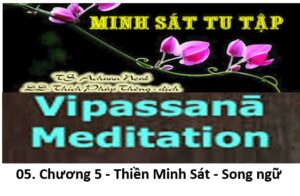
Chương 5 – Vipassanā Bhāvanā – Thiền Minh Sát
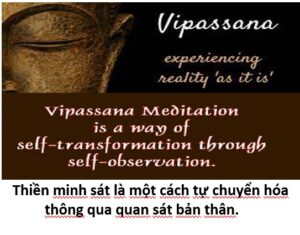 Thiền minh sát là một cách tự chuyển hóa thông qua quan sát bản thân.
Thiền minh sát là một cách tự chuyển hóa thông qua quan sát bản thân.
Vipassana [1] is the only practice that can lead the yogi to end suffering. This is the highest aim of Buddhism, and so the practitioner should know what Vipassana is:
Tuệ Minh Sát [1] là phương pháp tu tập độc nhất có thể dẫn dắt hành giả đi đến diệt khổ. Ðây là mục đích cao cả nhất của Phật giáo, và như vậy hành giả nên hiểu biết Thiền Minh Sát là gì?
1) Vipassana is the type of wisdom (panna) that knows nama-rupa are impermanent, suffering, and without self (not man, not woman). Other wisdoms are not Vipassana wisdom; only the wisdom that knows this. The Visuddhimagga-Magga says this is a special, “excellent wisdom”.
- Thiền Minh Sát là một hình thức trí tuệ (pañña) biết danh sắc là vô thường, khổ và vô ngã (không có đàn ông, đàn bà). Những loại trí tuệ khác là không phải là Tuệ minh sát (vipassanā-ñañā); chỉ có trí tuệ này mới biết điều này. Thanh tịnh đạo (Visuddhi Magga) nói rằng đây là một loại “trí tuệ kỳ diệu” đặc biệt.
2) The objects of Vipassana are rupa and nama in the present moment. If you are aware of something besides your own rupa and nama, you can”t realize the True State of the Nature (sabhava).
- Ðối tượng của Thiền Minh Sát là danh và sắc trong sát na hiện tại. Nếu hành giả nhận biết một điều gì, ngoài sắc và danh của bản thân mình, hành giả không thể nhận ra Trạng Thái Thật của Bản chất Vạn Vật (sabhava).
3) The duty of Vipassana is to destroy kilesa wherever it occurs at the six sense doors. Therefore, we have to practice to observe the present moment at the six sense doors, because kilesa occurs at that place.
- Nhiệm vụ của Thiền Minh Sát là đoạn trừ phiền não khi nó xảy ra bất cứ nơi nào ở sáu căn môn. Do đó chúng ta phải tu tập quan sát từng sát na hiện tại ở sáu căn môn, bởi vì phiền não xuất hiện ở nơi đó.
4) The benefit of Vipassana is to destroy vipallasa (perversity of perception) that thinks rupa is beautiful, rupa-nama is permanent, rupa-nama is happy, rupa-nama is personal. When Vipassana wisdom is very strong, it will lead to the end of suffering (nirodha) and hence nibbana.
- Lợi ích của Thiền Minh Sát là đoạn tận Vipallāsa (ảo tưởng) cho rằng sắc pháp là xinh đẹp, danh và sắc là trường tồn, hạnh phúc, danh và sắc là của ta.
Khi tuệ minh sát mạnh mẽ, nó sẽ dẫn đến sự chấm dứt khổ (Nirodha) và kể từ đó là Níp Bàn.
5) The practice of Vipassana uses the four foundations of Satipatthana as outlined in the MahaSatipatthana Discourse (the “Great Setting Forth of Mindfulness”).
- Sự tu tập Minh Sát Tuệ sử dụng Thiền Tứ Niệm Xứ (Satipatthana) như được vạch ra trong bộ kinh Ðại Niệm Xứ.
These dhamma are helpful:
Những pháp này (dhamma) rất hữu ích:
- a) Six Vipassana Bhumi (basic knowledge) [2]
- b) Sixteen Yanas
- c) Seven Purities
- a) Sáu nền tảng của Minh sát tuệ- Thiền Minh Sát (bhumi) [2]
b) 16 tuệ
c) Thất tịnh.
Vipassana bhumi are objects that we must observe when practicing Vipassana, in order to have Vipassana panna occur. There are six:
1) 5 Khandhas
2) 12 Ayatana
3) 18 Dhatu (elements)
4) 22 Indriya
5) 4 Noble Truths
6) 12 Paticcasamuppada
Các nền tảng Minh sát là những đối tượng mà chúng ta cần phải quan sát khi tu tập minh sát tuệ, để có được tuệ minh sát phát sanh, có sáu loại:
– Năm uẩn (Khandha)
– 12 xứ (Ayatan)
– 18 giới (yếu tố) 6 căn + 6 trần + 6 thức
– 22 căn
– Tứ Diệu đế
– 12 nhân duyên- Paticcasamuppada.
[1] Vipassanais actually the result (insight) from Satipatthana―i.e., the sixteen yanas―but today it has come to mean insight meditation.
[2] The word “bhumi” means place, or plane of existence (see 1.4.5). As here used, it means the place of various types of knowledge.
All of this, to put it briefly, is just rupa-nama, because the one who comes to practice Vipassana has only to observe rupa-nama. Rupa-nama are the objects to be seen by Vipassana panna, and which will bring the truth to Vipassana panna. That truth is knowing that nama-rupa are impermanent, suffering, and not-self. That panna is called Vipassana panna, and can destroy kilesa.
Tất cả điều này được tóm gọn lại chỉ là danh sắc, bởi vì một người đến với sự tu tập thiền thiền quán là quán sát danh sắc, và nó sẽ mang chân lý đến Tuệ minh sát (Thiền Minh Sát trí tuệ). Chân lý là sự biết rằng danh sắc là vô thường, khổ và vô ngã, trí tuệ (pañña) đó được gọi là Tuệ Minh sát, và có thể đoạn tận phiền não.
Vipassana bhumi is pariyatti (theory) and it is sabhava which is very deep and wide. The practitioner has to study the bhumi until they are understood completely. When he comes to practice, he has to know how to observe them (rupa-nama). For example, he has to know about the sense spheres (ayatana―Fig. 2-1) or the four postures. If he lacks pariyatti (theory) and doesn”t know how to observe nama-rupa, he cannot practice Vipassana in the right way and it (pariyatti) cannot be the paccaya for the result, because pariyatti, patipata (practice), and pativedha (result, insight, knowledge) depend on each other, and cannot work alone.
Nền tảng Minh sát là pariyatti (pháp học) và nó là sabhava thì hết sức sâu rộng. Hành giả phải tu học “bhumi” cho đến khi hiểu rốt ráo chúng. Khi vị này đến với sự tu tập phải biết cách nào để quan sát chúng (rup nàma). Ví dụ, vị này phải biết về dục giới (coi thuộc nhận thức của giác quan – xứ – Hình 2.1), hoặc Tứ uy nghi (đi, đứng, ngồi, nằm). Nếu vị này thiếu pháp học và không biết cách quán sát danh sắc), vị này không thể tu tập Minh sát đúng cách và pháp học không thể là paccaya (nhân) cho quả bởi vì pariyatti (pháp học), patipatti (pháp hành), và pativedha (pháp thành) dựa vào nhau, và không thể tiến hành riêng rẻ.
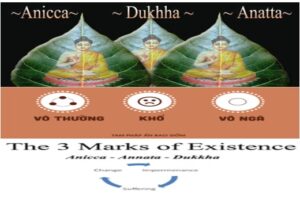 The Natural Law: The Three Signs of Being or The Three Marks of Existence, or Tam Pháp Ấn
The Natural Law: The Three Signs of Being or The Three Marks of Existence, or Tam Pháp Ấn
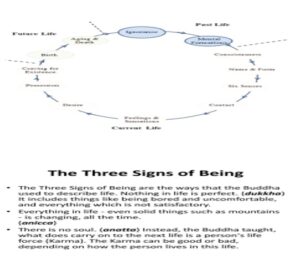 The Wheel Of Life or the Three Signs of Being
The Wheel Of Life or the Three Signs of Being
Vipassana must realize the Natural Law that says all existence has three characteristics: anicca, dukkha, anatta (also known as the Three Signs of Being). If one doesn’t know the Natural Law, it is called ignorance (avijja). Being ignorant of the Natural Law, one is still in samsara-vata (rebirth cycle) and can”t end suffering. The Scriptures define ignorance as not knowing the Four Noble Truths. If one doesn”t know the Natural Law, one can”t reach the Four Noble Truths, and so is ignorant of them.
Tuệ minh sát phải nhận thức định luật Tự nhiên cho rằng tất cả sự sống (sự hiện hữu) đều có ba đặc tính (tam tướng): vô thường, (anicca), khổ (dukkha) và vô ngã (anatta). Nếu một người không biết được Ðịnh Luật Tự Nhiên, được gọi là vô minh (avijjā). Không biết được Ðịnh Luật Tự Nhiên, người ấy vẫn chịu trong vòng sinh tử luân hồi (samsara-vatta), và không thể dứt khổ. Kinh điển định nghĩa vô minh (Avijjā) là không biết được Tứ Diệu Ðế. Nếu một người không biết Ðịnh Luật Tự Nhiên, người ấy không đạt được Tứ Diệu Ðế, và như vậy là vô minh.
1.5.1 Three Types of Practice Wisdom (as differing from worldly wisdom):
1.5.1. Ba loại Trí Tuệ Tu Tập (khác biệt với trí tuệ phàm tục):
1) Sutta panna [1] is knowing by pariyatti (theory) or hearing dhamma discussions, before practicing.
2) Cinta panna [1] is knowing by practicing, as we are doing now.
3) Vipassana panna is knowing by Vipassana panna that there is only rupa and nama, and they are impermanent, suffering, and without self.
- Trí văn (sutta pañña) [3] là sự biết được pháp học hoặc nghe thuyết pháp trước khi tu tập.
- Trí tư (cinta pañña) là sự biết được bằng cách tu tập, như chúng ta đang thực hiện bây giờ.
- Trí tu (vipassanā pañña) là sự biết được bằng tuệ minh sát, đó là chỉ có danh và sắc và chúng thì vô thường, khổ và vô ngã.
(Right theory will lead to right practice and right practice will lead to insight wisdom, or Vipassana.)
(Pháp học đúng sẽ dẫn đến sự tu tập đúng và pháp hành đúng sẽ dẫn đến tuệ giác).
[1] Technically, sutta panna means enlightenment wisdom reached through hearing theory. Cinta panna means to know by oneself, without a teacher. Only a Buddha has cinta panna. In this practice, however, we use sutta panna to mean understanding theory and cinta panna to mean applying correct theory to practice.
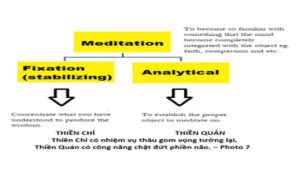
 Vipassana bhavana is different from samatha bhavana.
Vipassana bhavana is different from samatha bhavana.
Vipassana bhavana is different from samatha bhavana. If the yogi doesn”t know this, he might mix the two together and Vipassana panna can”t occur, and end suffering. Samatha bhavana is kusala, but it leads to tranquility and is still in samsara. (See difference between Samatha and Vipassana, Section 1.9.)
Tu tập thiền quán thì khác với Tu tập thiền chỉ. Nếu hành giả không biết điều này, có thể lẫn lộn hai loại với nhau và tu tập thiền không tiến triển, và không diệt khổ. Tu tập thiền chỉ là thiện pháp, tuy nó dẫn đến vắng lặng nhưng vẫn còn trong vòng luân hồi. (Xem sự khác biệt giữa Thiền chỉ, Thiền định và thiền quán, thiền minh sát ở Phần 1.9).
1.5.2 Samadhi
1.5.2. Ðịnh (samādhi)
Samadhi means concentration, or the results of concentration. In the latter sense, some teachers prefer the broader definition, “collectedness”. Samadhi is useful in Vipassana but only to the level of momentary concentration.
There are three basic types of concentration:
1) Kanika Samadhi―Momentary concentration.
2) Upacara Samadhi―High concentration, almost to the level of Apana Samadhi.
3) Apana Samadhi―Concentration in which the mind can remain steadfast on one object for long periods.
As noted above, only kanika samadhi (momentary concentration) is necessary for Vipassana practice.
Ðịnh có nghĩa là tập trung, hoặc kết quả của sự tập trung. Trong nghĩa sau, một số vị thầy thích định nghĩa mở rộng hơn. “sự gom lại”. Ðịnh rất ích lợi trong thiền quán nhưng chỉ đến mức độ tập trung tạm thời.
Có ba loại định (tập trung) cơ bản:
- Khaṇika Samādhi: Sát na định
2. Upacāra Samādhi – Cận định (sự tập trung cao)
3. Appana Samādhi – Nhập định, duy trì tâm vững chắc trên một đối tượng trong một thời gian dài.
Như được lưu ý ở trên, chỉ sát na định là cần thiết đối với sự tu tập Minh sát tuệ.
1.5.2.1 Kanika Samadhi
Sát na định – Khaṇika samādhi
The reason we have to use kanika samadhi for Vipassana is that kanika samadhi still remains in the six senses. When changing objects, for example, from sitting rupa to nama hearing (from mind sense to hearing sense), kanika samadhi can follow the change. Kanika samadhi is the basic tool to make Vipassana panna work. It is this changing of objects that allows the yogi to see the rising and falling away of cittas (mental states).
Lý do chúng ta phải dùng sát na định cho minh sát tuệ đó là sát na định vẫn còn nằm trong 6 căn. Ví dụ, khi thay đổi các đối tượng, từ oai nghi ngồi cho đến danh nghe (căn ý và căn thinh) cận định có thể theo sự thay đổi. Cận định là công cụ cơ bản để khiến cho Minh sát tuệ tiến triển. Chính sự thay đổi của các đối tượng này giúp cho hành giả thấy được sự sinh và diệt của các tâm thức.
When impermanence is seen in cittas, this impermanence means cittas are out of control and therefore dukkha and anatta. Upacara samadhi is just one-pointedness, and it cannot be used to see the rising and falling of cittas. When impermanence is realized in cittas, it has to be realized with wisdom, and not samadhi.
Khi thấy được sự vô thường trong tâm, sự vô thường này có nghĩa là tâm không kiểm soát được và do đó khổ và vô ngã. Ðịnh nâng cao đơn thuần chỉ là nhất tâm và nó không thể dùng để nhận thấy sự sanh và diệt của tâm.
Khi người nhận ra được sự vô thường trong tâm. Nó phải được nhận thức bằng Trí Tuệ và không phải định tâm.
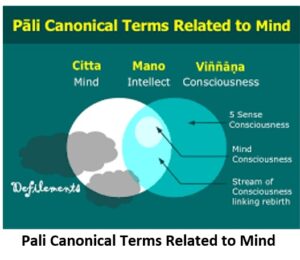 Pali Canonical Terms Related to Mind
Pali Canonical Terms Related to Mind
 When impermanence is realized in cittas, it has to be realized with wisdom, and not samadhi.
When impermanence is realized in cittas, it has to be realized with wisdom, and not samadhi.
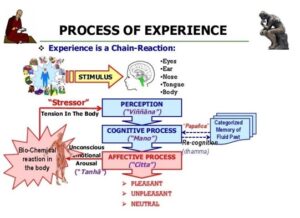
Process of experience, which is a chain-reaction.
*** *** ***
Sources:
Tài liệu tham khảo:
- https://tienvnguyen.net/images/file/Ek9kQjfF1wgQANp7/minhsattutap.pdf
- https://www.vipassanadhura.com/PDF/vipassanabhavana.pdf
- https://www.budsas.org/uni/u-gtmst/gtmst-11.htm
- https://theravada.vn/minh-sat-tu-tap-chuong-v-thien-minh-sat/
- Photo 2: https://www.greenunfolding.com/2014/11/what-vipassana-taught-me-about-ignorance-and-healing/
- Photo 3: http://evdhamma.org/index.php/dharma/dharma-lessons/item/1074-tam-phap-an-song-ngu
- Photo 3a: http://vipassana.nextohm.com/Buddha/The Wheel Of Life/
- Photo 4: http://evdhamma.org/index.php/dharma/dharma-lessons/item/1121-thien-la-gi-song-ngu
- Photo 5: http://evdhamma.org/index.php/documents/buddhist-meditation/item/72-chin-tang-tam-thuc-song-ngu
- Photo 6a: https://www.pinterest.com/ProtoBuddhism/charts-diagrams/
- Photo 6b: https://www.pinterest.com/pin/741194051149468657/
